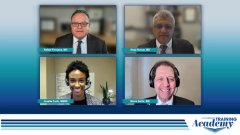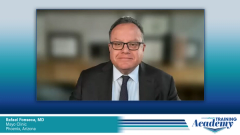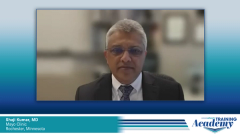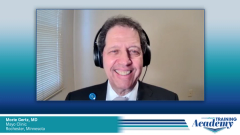
MajesTEC-1: Data Updates of Anti-BCMA Bispecifics in MM
Expert Shaji Kumar, MD, spearheads a review of data from MajesTEC-1 and use of teclistamab therapy in patients with relapsed/refractory multiple myeloma.
Episodes in this series

Transcript:
Rafael Fonseca, MD: We’re going to discuss briefly some of the data that has been presented, and then have, again, a conversation amongst ourselves regarding what does this mean for the clinical practice and best ways to incorporate them into the treatment for our patients. Dr Kumar, would you mind providing us some updated data from the MajesTEC-1 clinical trial of teclistamab that Dr Nooka has presented, and also how this relates to the approval of this particular antibody?
Shaji Kumar, MD: Thank you, Rafael. This was data that was presented at the last ASCO [American Society of Clinical Oncology] meeting. Dr Nooka had presented updated data from the larger cohort of the MajesTEC-1, 165 patients from this phase 1 and phase 2 study. And, again, teclistamab is the first bispecific antibody to be approved for treatment of multiple myeloma. And the results of this trial played a direct role in that initial approval. It is a BCMA [B cell maturation antigen]-targeted bispecific antibody and it has been approved, currently, for the treatment of patients with relapsed multiple myeloma who have had 4 prior therapies and have been exposed to an immunomodulatory drug, proteasome inhibitor, and an anti-CD38 monoclonal antibody. When you look at the 165 patients who were enrolled in this study, the majority of the patients had been exposed to all the available therapies. In fact, 77% of those patients were triple-class refractory, and nearly a third of them were refractory to all the 5 drugs in the 3 classes of drugs. There was a median of 5 prior lines of therapy, and these patients were roughly about 6 years out from their original diagnosis. And the data from the MajesTEC-1 trial was quite impressive despite the refractory nature of the disease. And nearly two-thirds of the patients had a response to therapy, including 60% of the patients who had a VGPR [very good partial response] and about 40% of the patients who had a complete response. In fact, when you look at the MRD [minimal residual disease] negativity, nearly a quarter of the patients achieved MRD negativity with the use of teclistamab in this trial. And when you look across the group, every subgroup of patients seems to have benefited from this drug. The responses were a little bit lower in those patients with high-risk disease, patients with significant extramedullary disease, and patients who had a significant amount of tumor in their bone marrow. So, certainly some aspects that would need to continue to improve upon with this class of therapy. Now, these responses are pretty durable with the median duration of response of about 18 and a half months amongst those two-thirds of the patients who responded to therapy. And in fact, when you look at the patients who had a complete response or better, their median duration of response was even longer. The median progression-free survival was just close to a year. And the median overall survival was about a year and a half. So, clearly a very effective therapy for a late stage of the disease in patients who have been exposed to pretty much everything available. In terms of the safety, the treatment was pretty well-tolerated. The main things were hematological toxicities, primarily cytopenia that in some patients took a while to recover, and cytokine release syndrome, which we'll be discussing later, is one of the common side effects of these immune therapies and was seen in about 70% of the patients, mostly grade 1 or 2 and easily managed. There were a fair number of patients with infections and about three-quarters of the patients had evidence of hypogammaglobulinemia. Seventy-six percent of the patients had infections. There were 19 deaths; 12 of them were related to COVID-19. But, again, hopefully that is an aspect that was highlighted by the fact that these trials were done during the peak of the pandemic. Hopefully going forward, we won’t be seeing those same numbers, but certainly there is an increased risk of infection with this class of agents that we need to be closely watching these patients for. The cytokine release syndrome, again, seen in 70% of the patients, is very well and easily managed with tocilizumab, and neurotoxicity was fairly infrequent in the study. Overall, the data is very supportive for the use of this class of drug, particularly teclistamab in patients with multiple prior therapies. Hopefully, the ongoing trials will demonstrate its value either by itself or in combination for early stages, as we'll talk about later in the course of this discussion.
Rafael Fonseca, MD: Thank you very much, Shaji. That was quite comprehensive and a very good summary of where we are right now with the clinical trials.
Transcript edited for clarity.
Newsletter
Stay up to date on recent advances in the multidisciplinary approach to cancer.























































































